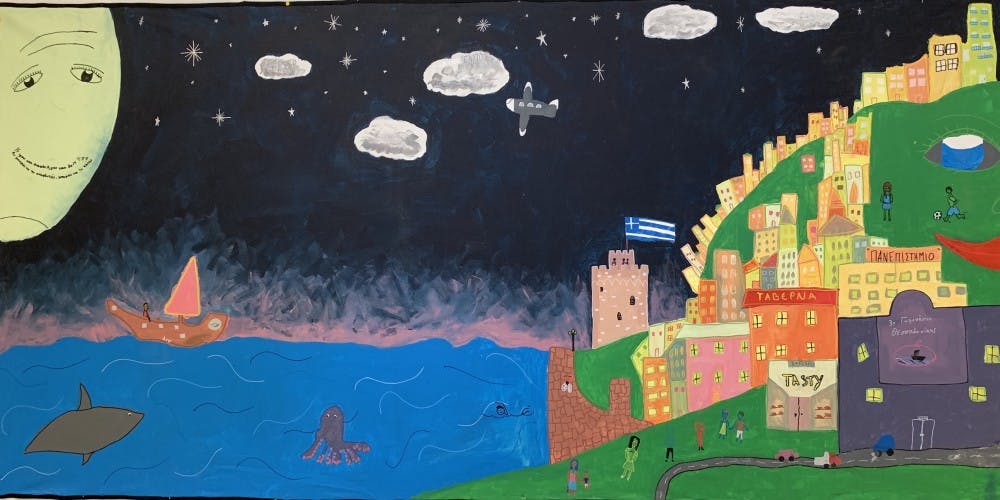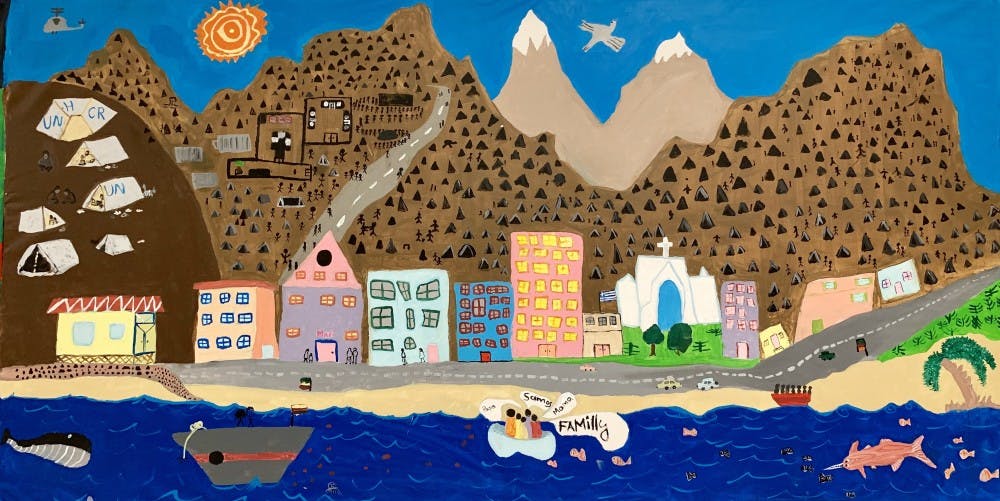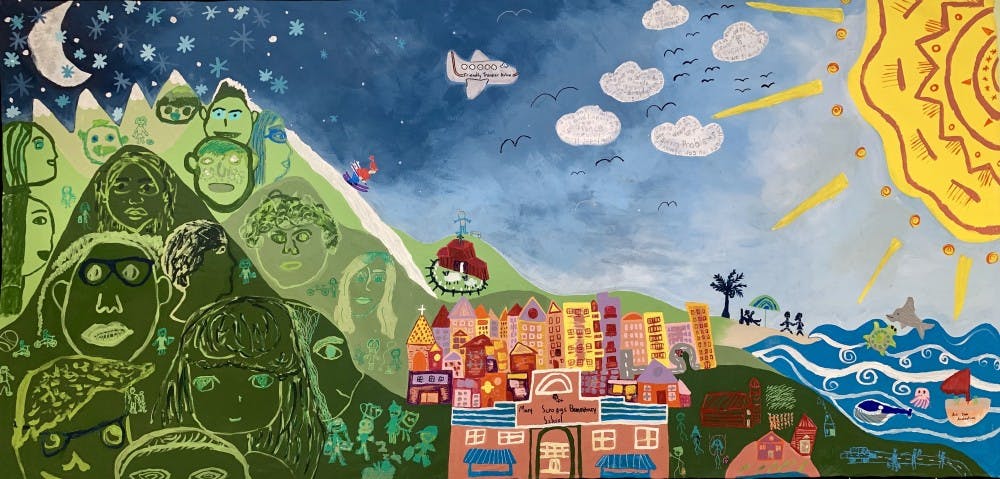A Chapel Hill-Carrboro City Schools art teacher spent the fall semester in Greece creating a mural with groups of students upon receiving an award from the Fulbright Distinguished Awards in Teaching in 2018.
Sarah Cornette, an art teacher at Mary Scroggs Elementary School, received the award to create Same Difference The Mural with students in her school as well as in Greece, said Stuart Phillips, communications specialist for Chapel Hill-Carrboro City Schools.
She worked with three different groups of students: one at her home school, another at a school in Thessaloniki, Greece and another group living in a refugee camp on Samos Island, Greece.
“With her art therapy background, she just has an extraordinary depth of understanding and, I don’t know, it’s kind of magic,” said Phillips.
The Fulbright Awards
Cornette’s trip to Greece and the mural project was made possible by the Fulbright Distinguished Awards in Teaching Semester Research Program, which is awarded to accomplished United States K-12 teachers from public, private and charter schools.
The Fulbright program aims to promote mutual understanding between the United States and other countries, and the teacher grants are specifically to encourage the exchange of best practices in education, help teachers build professional networks of like minded educators and bring cultural knowledge back to the U.S., according to the program website.
Teachers go abroad for three to six months to conduct research based on an inquiry project they develop when applying. The teachers then display their project through a website, book, or article.
Upon returning to the United States, teachers are encouraged to share the results of their research with their community in order to spread the wealth.

Part two of "Same difference: The mural," completed by students in Thessaloniki, Greece. Photo courtesy of Sarah Cornette.
Artists in action
Cornette said her plan for the mural was to have students answer the question: what is important to our community?
All of the students began by drawing images to answer this question and then voted as a group on which images they wanted in their final composition. Cornette used Adobe Photoshop to project the images onto the canvas so that the students could paint them.
“It was really important to me that this not be an adult’s version of what kids think of, that it be their line work that we projected onto the screen and then their hands creating the image,” said Cornette.
The mural is composed of three connected panels, the first of which was painted by fourth and fifth graders at Scroggs Elementary, said Cornette.
The Scroggs students chose to make a painting that was representative of their community, showing their school as front and center of the panel.
“School is so important to kids, I mean it’s a primary part of their world,” said Cornette.
They also chose to include self portraits in the mountain, because they decided that people are the foundation of their community.
The students left messages in the clouds in the painting for the other students who would see it, Cornette said.
When Cornette went to Greece, she did not know who she would be working with or how she would work with them.
The first group of Greek students Cornette worked with were in a school in the university town of Thessaloniki, Greece. She spent several weeks meeting with students for three hours per week to complete their piece of the mural with the help of a translator.
She chose the school because she thought it was experiencing things similar to what CHCCS is experiencing. She intended to work with students in schools that had refugees and economically disadvantaged students in attendance so that she could study their integration into the school and bring it back to her own district.
She quickly realized that there were no refugee children in the schools.
This group chose to create a reflecting composition of the first groups’ panel, while still representing their own community. The panel contains images important to their community, like the White Tower of Thessaloniki.
In order to work with refugee children, she went to Samos Island and worked with an NGO called Still I Rise in a refugee camp.
She held art class in a make-shift school in town near the refugee camp. The center is called Mazí, which is Greek for “together,” Cornette said.
Though seated at the outskirts of a beautiful tourist town on a harbor, the refugee camp was intense, crowded and lacking in resources.
“It’s one of the worst places in the world for refugees right now,” said Cornette.
Cornette said the camp, designed for 650 people, held around 5,000 people while she was there.

Part three of "Same difference: The mural," completed by students at a refugee camp in Samos Island, Greece. Photo Courtesy of Sarah Cornette.
The third panel of the mural was created over the course of four days. The kids who came were mostly from the Democratic Republic of the Congo, South Sudan, Iraq and Afghanistan, Cornette said.
Very few students spoke any English, and they didn’t all speak the same language, making it difficult to communicate with one another.
Despite a language and cultural barrier, the students created a piece that resembled those of the other two groups of students.
What was important to these students was to map out the camp and to include important monuments to them, such as the food line, the medical center and the sheer number of tents and people living there. It was important to the kids to make the camp large on the canvas in order to represent how large it felt to them, Cornette said.
The Same Difference
Though Cornette worked with students from different backgrounds and experiences, she said connecting with the kids through art was almost exactly the same.
“Kids love to make art,” said Cornette. “And painting is a joyful process.”
She said the students in Greece were grateful for the opportunity to create.
“They were stoked to be making something this big and this intricate and something that was just, from start to finish, imbedded with their ideas,” said Cornette.
It is validating for students to be told by their teacher that they will be creating exactly what they want and that their skills will be shown, Cornette said.
“For the children, I think it was the idea that I was bringing it back, that they would feel seen,” said Cornette.
Cornette was surprised by the joy of the Greek students, but also by the profoundness of their composition, said Cornette.
“They chose these dark colors and dull colors for the camp and that seemed more suitable than the reality of their situation, which was this patchwork of like crazy colored plastic pieces,” said Cornette. “Not all these tents are gray, but they were like ‘this shows the darkness of our lives up here and how we see this place.’ They picked the colors and they were very symbolic and I thought it meant a lot.”
Those residing in the camp, who have not yet received refugee status, are given a piece of paper with a number on it. While waiting to be called they live in the camp as opposed to other places on the island.
“The reason is because they have some access to resources, if they get in the food line early enough, they may get food that day, which is great, they have some access to health care," Cornette said. "But, the main thing is if their number gets called and they can’t find you, then there’s nothing you can do, so you have to be where they can find you."
She also said that the people in the camp are depersonalized in the painting to reflect how they really felt, which was that they were living as just a number.
The next steps
The mural has had an impact on the students at Scroggs who have seen it since Cornette’s return to the school, so much so that she has gotten feedback from parents about the project. She plans on presenting the mural at larger institutions as well.
Though she doesn’t know what impact the mural will ultimately have, Cornette said it has inspired others to want to connect with it and to want her to show and speak about it.
“It’s a work of art, which means that its impact, hopefully, will have a life of its own as all artworks should, beyond my ability to interpret it,” Cornette said.
But first, Cornette is taking her art westward.
"I have decided it isn’t complete until I take it to migrant detainee camps on our southwest border and get the children being held there to add their voices to this project," Cornette said.
Clarification: A statistic was removed from the article at the request of the IREX organization. Attributions from a prior reference for this story were also removed.
To get the day's news and headlines in your inbox each morning, sign up for our email newsletters.

